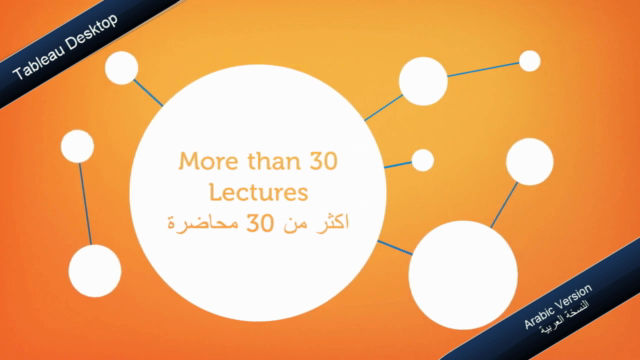دليلك الكامل لتعلم تابلو باللغة العربية - Tableau
المرجع الكامل لكل ما تريد معرفته عن برنامج تابلو المكتبي ودليلك للنجاح في امتحان تابلو والحصول علي شهادة تابلو الرسمية
4.52 (84 reviews)

1 131
students
9.5 hours
content
May 2021
last update
$49.99
regular price
Why take this course?
Based on the outline provided, you're preparing a curriculum for a training session on Tableau, which is a powerful data visualization and business intelligence tool. Here's a detailed breakdown of what each day's section covers, along with some additional comments that could be helpful when delivering the training:
Day 1 - Section 2: [Tableau Data Source]
- Data sources are the starting point for any analysis in Tableau. They can be local files (like Excel), databases, or even live connections to data sources.
- Connect to an Excel file: Start with a familiar format to users, as it's easy to understand and manipulate before diving into more complex data sources.
- Data connection and data source: Explain how to create a new data source and the differences between a live connection (real-time data) and extract (snapshot of data at the time of extraction).
- Live vs Extract: Discuss the pros and cons of each, such as the difference in performance and freshness of data.
- Data source filters: Show how to refine the data you're bringing into Tableau using filters, which can be either extract or SQL filters.
Day 2 - Section 1: [Data preparation]
- Data preview panel: Introduce the initial view of the data that users see upon connecting a data source.
- Change field type: Explain how to modify data types for fields, which can be crucial for accurate analysis and visualization.
- Rename fields: Teach users how to make their data more understandable by renaming complex or unclear field names.
- Split columns: Show how to break a single column into multiple columns based on delimiters or fixed character counts.
- Create new dimension and measures: Guide users through creating dimensions (grouping of facts) and measures (numeric fields that can be aggregated).
- Metadata view: Explain the importance of understanding the metadata, which includes field names, data types, and roles.
- Data Joins: Demonstrate how to combine datasets based on common keys or attributes.
Day 2 – Section 2: [Main visualization features]
- Introduction to Tableau interface: Provide an overview of the Tableau environment, including the various panes and tools available.
- Label, Sort, Group, Filter, Hierarchy, Alias, Pages, Sets: Explain these features as they relate to creating more detailed and customized visualizations.
- Calculated Fields: Introduce users to the power of calculations that can be used for unique analysis or to create new data points.
- View underlying data: Teach how to access and understand the underlying data in your visualization, which is essential for validation and trust in your insights.
Day 3 – Section 1: [Tableau’s basic terminologies]
- Dimensions and measures: Explain these fundamental concepts, as they form the basis of most analysis in Tableau.
- Discrete vs Continue: Clarify the difference between dimensions (discrete) and measures (continuous), which affects how data can be used in various visualizations.
- Marks type, color, size, label, tooltip, shapes: Discuss how to encode different aspects of your data through Tableau's marks card.
- Dual axes: Explain the difference between dual axes and how to use them to compare two sets of measurements at once.
Day 3 – Section 2: [Tableau charts]
- Cover each type of chart, explaining its usage and when it's most appropriate to use it.
- Show me: Introduce Tableau's interactive analysis feature that suggests visualizations based on the data selected.
Day 4 – Section 1: [Visualization advanced topics]
- Discuss how to provide context to your data with features like analytics (reference lines, trends, and forecasts).
- Quick table calculations: Explain the built-in calculation options for quick summaries or comparisons.
- Copy formatting: Show how to apply existing formatting to new visualizations or fields to maintain consistency in your dashboard.
- Clustering: Introduce clustering as a way to identify patterns in data and segment it.
- Parameters: Explain parameters as a means of creating interactive, user-driven dashboards.
- Blending: Teach how to combine data from multiple data sources (blending) to create comprehensive visualizations.
- Level of Detail expressions (LOD expressions): Explain how to preserve the context of aggregated data in complex analyses.
Day 4 – Section 2: [Interactive dashboards]
- Discuss how to make dashboards interactive, allowing users to filter and explore data on their own.
- Action and filters: Show how actions can drive multiple visualizations in response to a single user interaction.
Day 5: [Finalizing and sharing insights]
- Dashboard creation: Teach how to create a dashboard by combining multiple visualizations.
- Formatting and layout: Discuss best practices for formatting and laying out dashboards for clarity and effectiveness.
- Sharing and embedding: Explain how to share dashboards with others via Tableau Server or Tableau Public, and how to embed them in websites or applications.
- Publishing workbooks and data sources: Show how to save and publish Tableau workbooks and data sources so they can be accessed by others.
Day 5 – Section 2: [Best practices and real-world application]
- Data storytelling: Encourage users to create a narrative with their data, guiding them on how to tell compelling stories with visualizations.
- Performance optimization: Offer tips for optimizing dashboards for performance, especially when dealing with large datasets or multiple complex visualizations.
- Security and governance: Discuss the importance of securing data and maintaining control over who can view or edit Tableau content within an organization.
Remember to include interactive sessions where participants can practice what they've learned. This hands-on approach will help solidify their understanding and improve their confidence in using Tableau effectively. Additionally, consider providing resources for further learning, such as the Tableau community forums, documentation, and online courses.
Course Gallery




Loading charts...
Related Topics
2475304
udemy ID
24/07/2019
course created date
04/10/2019
course indexed date
Bot
course submited by